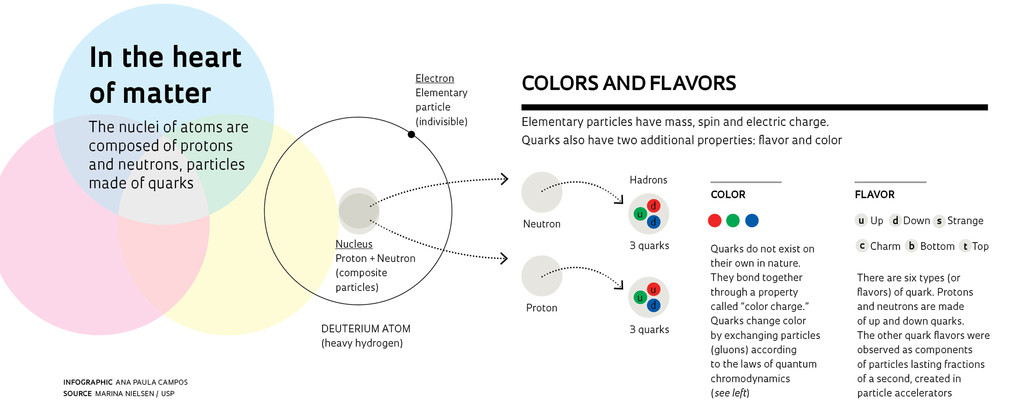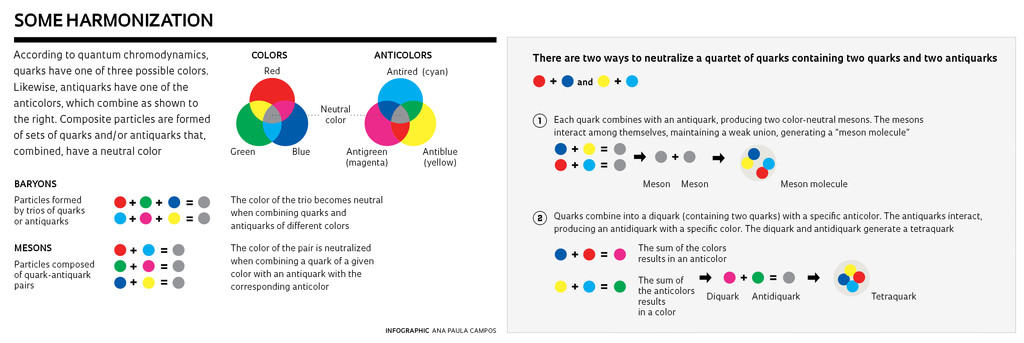
FERMILAB VISUAL MEDIA SERVICES
The Tevatron particle accelerator in Batavia, United States: the most powerful until the LHC was builtFERMILAB VISUAL MEDIA SERVICESOn February 25, 2016, physicists from the international collaboration DZero announced the discovery of a new subatomic particle: X(5568). The new particle is not elementary—indivisible—like the electron, the photon or the Higgs boson. Instead, X(5568) is composed of four smaller particles of a type already known: the quark. This is why it is classified as a tetraquark.
The novelty of X(5568) is the unusual combination of the four quarks. This rare type of particle—the most common are formed of two or three quarks—has been observed since 2003. But X(5568) is the first tetraquark made of completely different types. Discovering all the ways in which quarks can combine helps physicists better understand what is called the strong nuclear interaction. This is a fundamental force that maintains quarks together and is the source of most of the mass and energy of the protons and neutrons in atomic nuclei.
The researchers found evidence of the existence of the new tetraquark when analyzing the data collected over a period of nine years by the DZero particle detector, one of the instruments in the Tevatron accelerator at Fermi National Laboratory (Fermilab) in the United States. The accelerator was deactivated in 2011, three years after losing its claim to being the highest energy particle accelerator in the world to the Large Hadron Collider (LHC) of the European Organization for Nuclear Research (CERN) in Switzerland. The DZero collaboration involves researchers from seven Brazilian research institutions, including the Brazilian Center for Physics Research (CBPF) in Rio de Janeiro.
The announcement of the discovery prompted other international collaborations of physicists to seek evidence of the existence of X(5568) in their data. As this issue was going to press, only one group carrying out the LHCb experiment, using one of the four LHC particle detectors, had announced the results of their analyses. “We sought evidence of the tetraquark found by DZero and found nothing,” says Ignácio Bediaga, coordinator of the CBPF physicists who work on LHCb. “The DZero result, however, is very good and their analysis is very consistent,” he stresses. “My guess is that we have uncovered a new phenomenon.”
Bediaga explains that the LHCb team searched for signs of the existence of the X(5568) in their data on the creation of particles called B mesons and pi mesons, each consisting of two quarks. Equipment such as the LHC usually accelerates particles made up of many quarks—such as protons—to nearly the speed of light. When they collide, the protons break apart and result in fleeting particles of all possible types, some made up of quarks. One could be the X(5568), a particle with a very short life, which breaks into two types of particles with smaller masses in a fraction of a second. Each X(5568) could give rise to a B meson and a pi meson, both with very specific energy values. Physicists would therefore observe an excess of B and pi mesons with these energies—something DZero saw and LHCb did not.
There is, however, an important structural difference between the two detectors that may be allowing the tetraquark to escape detection by the LHCb, explains Bediaga. The LHCb was designed to detect the particles that arise in a direction very similar to the propagation direction of the colliding proton beams. But the DZero was a detector similar to CMS and Atlas, two other LHC detectors. These detectors are barrel-shaped and were designed to capture the particles that appear moving in all directions around the beam. It is possible that the X(5568) is being created in LHC collisions, but is following trajectories beyond the reach of LHCb.
“If CMS or Atlas find the X(5568), we are facing a very interesting puzzle,” says Bediaga. “If they do not find it, perhaps the analysis of the DZero team contains an error that has not been discovered.”
Colorful dynamics
“When only one experimental collaboration sees a new Tetraquark, we mistrust it,” says theoretical physicist Marina Nielsen of the University of São Paulo (USP). She coordinates a team that was one of the first in the world to perform calculations finding that, if confirmed, the X(5568) observed by the DZero may actually be a tetraquark.
Nielsen and her colleagues Jorgivan Dias and Alberto Torres, from USP, and Kanchan Khemchandani and Carina Zanetti, from Rio de Janeiro State University, raced against time from February 25–29, 2016 to determine whether the mass and other properties of the new tetraquark could be explained by the strong nuclear interaction.
Tetraquarks are extremely rare particles, which began to be observed only in recent years due to the increasing energy of collisions in particle accelerators and the greater sensitivity of their detectors. Their existence was predicted in 1964 by theoretical physicists George Zweig and Murray Gell-Mann, the first to propose the idea that many of the tens of particles observed in accelerators of the time, including protons and neutrons, were made of pairs or trios of quarks. Zweig and Gell-Mann’s theories were proven and refined by various physicists over the following decades, giving rise to quantum chromodynamics, a theory that also predicts the existence of quartets and quintets of quarks (see infographic).
It was not until 2003 that experiments in different particle accelerators confirmed the existence of a tetraquark, X(3872). Since then, international collaborations have confirmed the observation of 15 candidate tetraquarks and, in July 2015, the group operating the LHCb experiment announced the discovery of two pentaquarks: Pc(4450) and Pc(4380).
There may be other particles composed of combinations of more quarks and their antiparticles—antiquarks—as long as the arrangements follow the rules of quantum chromodynamics. “This theory allows any combination of four, five or more quarks, as long as a property called color charge is always neutral,” says Nielsen.
She and her colleagues are experts in a mathematical method called “sum rules” to perform calculations similar to those proposed by quantum chromodynamics. This method is necessary because the general principles of quantum chromodynamics appear to be simple, but its mathematical equations are among the most intractable of all physics, and it is impossible to solve them exactly, even with the help of supercomputers.
Based on the sum rules, Nielsen and her group calculated the mass and other observed properties of X(5568) and concluded that they can be explained if the particle is composed of two quarks (up and bottom) and two antiquarks (strange and down). Her calculations, however, do not rule out another possibility. Instead of forming a true tetraquark, X(5568) could be interpreted as two mesons (each containing two quarks) joined very weakly. This combination, called a meson molecule, is an alternative way of neutralizing the color charges and is therefore permitted under quantum chromodynamics. Nielsen’s collaborators are soon expected to finish new calculations assuming X(5568) is a meson molecule. If they calculate a mass different from that measured by DZero, they will know that the X(5568) cannot be a meson molecule. But if the value calculated is similar to that measured, the question will remain unsolved.
Project
Hadron physics (nº 2012/50984-4); Grant Mechanism Thematic Project; Principal Investigator Marina Nielsen (IF-USP); Investment R$290,720.00.
Scientific articles
ABAZOV, V. M. et al. Observation of a new B0s π ± state. Physical Review Letters. In production.
DIAS, J. M. et al. A QCD sum rule calculation of the X±(5568) → B0s π ± decay width. arxiv.org pdf/1603.02249v1.pdf.
ZANETTI, C. M.; NIELSEN, M. and KHEMCHANDANI, K. P. A QCD sum rule study for a charged bottom-strange scalar meson. arxiv.org/pdf/1602.09041.pdf.

